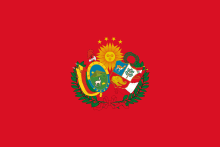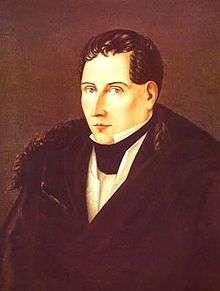Andrés de Santa Cruz
| Andrés de Santa Cruz | |
|---|---|
 | |
| 9th President of Perú | |
|
In office 27 January 1827 – 9 June 1827 | |
| Preceded by | Simón Bolívar |
| Succeeded by | Manuel Salazar y Baquíjano |
| Interim President of Perú | |
|
In office 11 August 1836 – 25 August 1838 | |
| Preceded by | Felipe Santiago Salaverry |
| Succeeded by | Agustín Gamarra |
| 7th President of Bolivia | |
|
In office 24 May 1829 – 20 February 1839 | |
| Vice President |
José Miguel de Velasco (1829–35) Mariano Enrique Calvo (1835–39) |
| Preceded by | José Miguel de Velasco |
| Succeeded by | José Miguel de Velasco |
| Supreme Protector of the Peru-Bolivian Confederation | |
|
In office 28 October 1836 – 20 February 1839 | |
| Personal details | |
| Born |
December 5, 1792 Huarina, Upper Peru, Viceroyalty of the Río de la Plata |
| Died |
September 25, 1865 (aged 72) Beauvoir, France |
| Spouse(s) | Francisca Cernadas |
Andrés de Santa Cruz y Calahumana (December 5, 1792, Huarina, Bolivia – September 25, 1865, Beauvoir, France) was President of Peru (1827) and Bolivia (1829–39). He also served as Supreme Protector of the short-lived Peru-Bolivian Confederation (1836–39), a political entity created mainly by his personal endeavors.
Early life and education
Santa Cruz was born on December 5, 1792 in the village of Huarina, close to La Paz, which at that time had been recently transferred from the Viceroyalty of Peru to the Viceroyalty of the Río de la Plata. His father was José Santa Cruz y Villavicencio, a Spaniard, and his mother Juana Basilia Calahumana, an Indian and cacique of the town of Huarina. In later years, Andrés de Santa Cruz would claim that through his mother, he descended directly from Inca rulers.[1] He began his studies in his hometown at the San Francisco Convent, and continued them at the San Antonio Abad Seminary in the city of Cuzco. In 1809 he left the seminary and returned to La Paz.
Military career
After Santa Cruz's return home, his father enrolled him as an alférez in the Dragones de Apolobamba Regiment of the Spanish Army. As such, he participated in the battles of Guaqui (July 20, 1811), Vilcapugio (October 1, 1813) and Ayohuma (November 14, 1813). The latter resulted in the defeat of the Argentine Independentist forces attempting to liberate the Upper Peru (modern day Bolivia) from Spanish rule. Santa Cruz also took part in the Spanish colonial campaigns to suppress the insurrection of Mateo Pumacahua (1814–15), further demonstrating his loyalty to the Spanish Crown. His luck ran out at the Battle of La Tablada (April 15, 1817), where he was captured and taken as prisoner of war to Buenos Aires. He managed to escape, first to Rio de Janeiro and then to Lima. As a reward, he was named Commander of Chorrillos.
War of Independence
At the time of the landing of the rebel army of José de San Martín on the Peruvian coast, Santa Cruz was commander of militia forces in the region of Huarochirí. In that position, he fought against the independetist in the Battle of Pasco (December 6, 1820), but the royalists were defeated and Santa Cruz captured. Taken to San Martin's headquarters at Huaura, he decided to switch sides and joined the Patriot Army (January 8, 1821). Santa Cruz ascended rapidly, reaching the rank of Colonel later that year and that of Brigade General in 1822 for leading Peruvian troops at the Battle of Pichincha (24 May 1822).
He revolted against the Peruvian Congress on February 26, 1823, and forced it to elect José de la Riva Agüero as President. As commander of a Peruvian Army expedition, Santa Cruz occupied the port of Arica and defeated a royalist army at the Battle of Zepita (August 27, 1823). Failing to exploit his victory, he retreated hastily.
When Simón Bolívar assumed the presidency of Peru (February 17, 1824), Santa Cruz joined his army and was named Chief of Staff of the Peruvian Division. In that condition, he participated of the Battle of Junín (August 6, 1824). Afterwards, he was named Prefect of Ayacucho, and then Chief of Staff of the Patriot Army during the campaign for the liberation of Bolivia. As a reward for his actions, Santa Cruz received the titles of Marshal and Prefect of Chuquisaca in April 1825.
Named President of the Government Council in Lima, he was in charge of the Peruvian Executive after Bolívar returned to Gran Colombia on September 4, 1826, until the collapse of the Bolivarian regime in Peru on January 27, 1827. Santa Cruz temporarily assumed the post of President until June 9, 1827, when José La Mar was elected by Congress.
President of Bolivia
Removed from power, Santa Cruz was named Peruvian ambassador to Chile, but he was recalled to Bolivia where he had been proclaimed as President. Sworn in on May 24, 1829, he found a country afflicted by endemic internal disorders and very near to bankruptcy. Measures undertaken to resolve these problems included purging conspirators, reforming and strengthening the Army, reforming the bureaucracy, reforming public finances, issuing new currency, issuing a new Constitution, issuing a new Civil Code based on the Napoleonic Code and establishing Cobija as a free port. The authoritarian regime imposed by Santa Cruz brought stability to Bolivia at a time when most countries in Latin America faced widespread unrest. Furthermore, it formed a solid base from which to pursue his main project, the Peru-Bolivian Confederation.
Peru-Bolivian Confederation

As President of Bolivia, Santa Cruz instigated several failed plots to achieve a political union with Peru, taking advantage of that country's chronic political unrest. His best opportunity came in 1835 when the Peruvian President Luis José de Orbegoso requested his assistance to fight the rebel army of Felipe Santiago Salaverry. Santa Cruz defeated Peruvian caudillo Agustín Gamarra at the Battle of Yanacocha (August 13, 1835) and Salaverry at the Battle of Uchumayo (February 4, 1836) after which he had Salaverry summarily executed.
At the instigation of Santa Cruz, a Congress of the Peruvian southern departments (Arequipa, Ayacucho, Cuzco and Puno) gathered at Sicuani and declared the establishment of the Republic of South Peru (March 17, 1836). A similar assembly at Huaura of the northern departments (Amazonas, Junín, La Libertad and Lima) founded the Republic of North Peru (August 11, 1836). Both recognized Santa Cruz as Supreme Protector with extensive powers, which enabled him to create the Peru-Bolivian Confederation on October 28, 1836. He summoned to the city of Tacna representatives of both legislatures together with those of the Bolivian Congress assembled at Tapacarí to establish a Constitution for the new State. Under his direction, they signed a pact on May 1, 1837 which named him Supreme Protector for a ten-year period.

Invested with considerable powers, Santa Cruz endeavoured to establish in Peru the same type of authoritarian order he had imposed in Bolivia. He issued a Civil Code, a Penal Code, a Trade Regulation, a Customs Regulation and reorganized tax collection procedures allowing an increase in state revenues while restraining expenditures. The Confederation generated resistances among several groups in both countries, who resented the dilution of national identities. An important number of Peruvian politicians opposed to the idea of the Confederation fled to Chile, where they received support from the powerful Minister Diego Portales. Together they amassed a military expedition against Santa Cruz, led by Admiral Manuel Blanco Encalada, but they were encircled by Santa Cruz and had to surrender by the Treaty of Paucarpata, signed on November 17, 1837. The Chilean Government organized a second expedition, which defeated the Supreme Protector at the Battle of Yungay (January 20, 1839) and forced the dissolution of the Confederation.
Later years
After resigning from his post as Supreme Protector (February 20, 1839), Santa Cruz fled to Ecuador from where he plotted unsuccessfully to regain power. On October 13, 1843 he disembarked at Camarones in the Peruvian province of Tarapacá but was captured while trying to reach Bolivia. Delivered to the Chilean Government, he was imprisoned at Chillán from 1844 until 1846 when he was freed. He was named ambassador to several European countries by Manuel Belzú (1848–55) and then ran for president of Bolivia but was defeated by General Jorge Córdova. After staying for a while in Argentina, he returned to France where he lived the rest of his life at Versailles. He died at Beauvoir, near Nantes on September 25, 1865. One hundred years later, in 1965, the remains of the old Marshal were repatriated from France by the military government of the day and reinterred ceremoniously beside the Presidential Palace in Bolivia.
See also
References
- Basadre, Jorge, Historia de la República del Perú. Editorial Universitaria, 1983.
- Sobrevilla Perea, Natalia . The Caudillo of the Andes: Andres de Santa Cruz (Cambridge University Press; 2011); 256 pages; a biography
- Tauro del Pino, Alberto, Enciclopedia Ilustrada del Perú. Peisa, 2003.
| Political offices | ||
|---|---|---|
| Preceded by Simón Bolívar |
President of the Government Council of Perú 1826–1827 |
Succeeded by José de La Mar |
| Preceded by José Miguel de Velasco |
President of Bolivia 1829–1839 |
Succeeded by José Miguel de Velasco |
| Preceded by Confederation created |
Supreme Protector of the Confederacy 1836–1839 |
Succeeded by Confederation dissolved |
